Cyclopamine inhibition of human breast cancer cell growth independent of Smoothened (Smo)
- PMID: 18563554
- PMCID: PMC5300001
- DOI: 10.1007/s10549-008-0093-3
Cyclopamine inhibition of human breast cancer cell growth independent of Smoothened (Smo)
Abstract
Altered hedgehog signaling is implicated in the development of approximately 20-25% of all cancers, especially those of soft tissues. Genetic evidence in mice as well as immunolocalization studies in human breast cancer specimens suggest that deregulated hedgehog signaling may contribute to breast cancer development. Indeed, two recent studies demonstrated that anchorage-dependent growth of some human breast cancer cell lines is impaired by cyclopamine, a potent hedgehog signaling antagonist targeting the Smoothened (SMO) protein. However, specificity of cyclopamine at the dosage required for growth inhibition (> or =10 microM) remained an open question. In this paper we demonstrate that hedgehog signaling antagonists, including cyclopamine, and a second compound, CUR0199691, can inhibit growth of estrogen receptor (ER)-positive and ER-negative tumorigenic breast cancer cells at elevated doses. However, our results indicate that, for most breast cancer cell lines, growth inhibition by these compounds can be independent of detectable Smo gene expression. Rather, our results suggest that cyclopamine and CUR0199691 have unique secondary molecular targets at the dosages required for growth inhibition that are unrelated to hedgehog signaling.
Figures


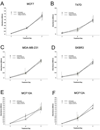
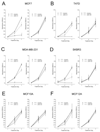

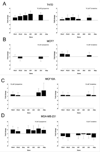
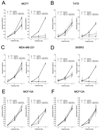

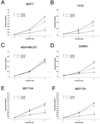
References
-
- Lewis MT, Veltmaat JM. Next stop, the twilight zone: hedgehog network regulation of mammary gland development. J Mammary Gland Biol Neoplasia. 2004;9:165–181. - PubMed
-
- Hooper JE, Scott MP. Communicating with Hedgehogs. Nat Rev Mol Cell Biol. 2005;6:306–317. - PubMed
-
- Nusse R. Wnts and Hedgehogs: lipid-modified proteins and similarities in signaling mechanisms at the cell surface. Development. 2003;130:5297–5305. - PubMed
-
- Cohen MM., Jr The hedgehog signaling network. Am J Med Genet. 2003;123A:5–28. - PubMed
Publication types
MeSH terms
Substances
Grants and funding
LinkOut - more resources
Full Text Sources
Other Literature Sources
Medical
Miscellaneous

